Horizontal juniper: the best varieties, their planting and care rules
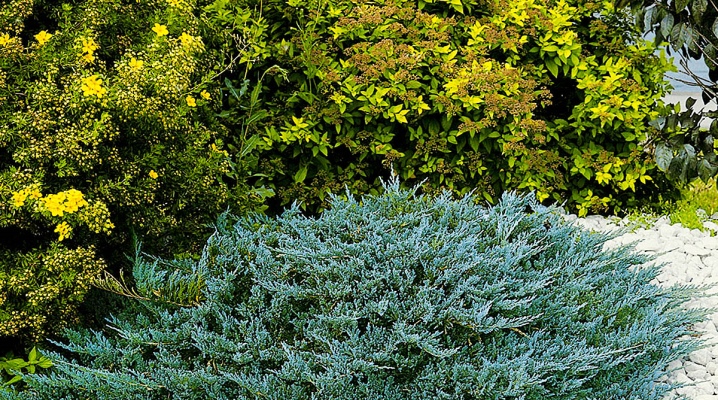
In household plots and dachas, you can often see a plant with dense needles of a rich color, which spreads along the ground, forming a dense, beautiful carpet. This is a horizontal juniper, which has recently become very popular in landscape design.
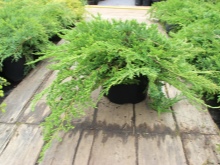
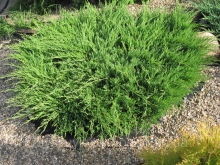
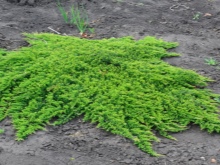
Peculiarities
This fragrant evergreen coniferous plant is a member of the cypress family of junipers. North America is considered his homeland.
Juniper horizontal (prostrate) is a dioecious creeping shrub with long, slightly bent upward shoots, growing horizontally, on which there are a lot of short lateral processes. With a low height (from 10 to 50 cm), the diameter of its crown is large in size - from 1 to 2.5 m.

The needles can be in the form of needles, the size of which is about 3-5 mm, and oblong-shaped leaves-scales of a very small size - 1.5-2 mm. The color of the needles can be deep green, gray-green, and in some varieties with a bluish, white or silvery-yellow tint. In winter, the needles often turn brown or purple in color.
Flowering occurs in May, and the fruits are formed in June or July. Its fruits are cone berries of a dense dark blue, almost black, color with a rounded shape and a size of about 6 mm. Their maturation lasts 2 years.
Juniper is characterized by a very slow growth: it grows no more than 1 cm per year. It adapts well to any conditions.
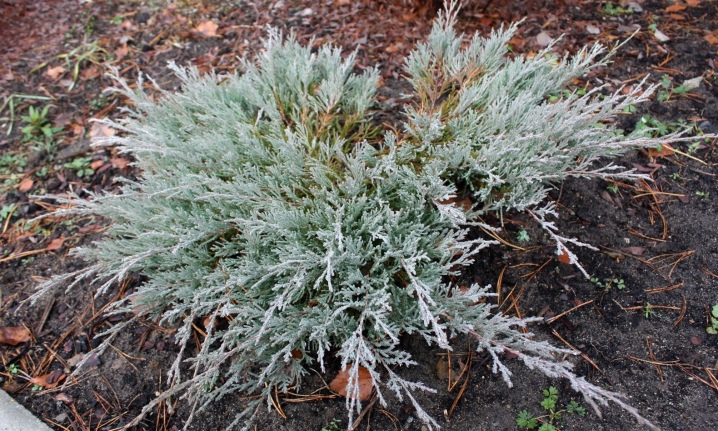
Review of popular varieties
There are more than 100 species of prostrate juniper, including hybrids. Many of its varieties are popular with gardeners and designers. Here is a description of some of them.
"Andorra compact"
The bush of this variety has a neat crown, shaped like a pillow. The height is within 10 cm, the diameter of the dense crown is up to 1 m. Twigs growing at a certain angle from the middle of the bush are covered with scaly needles of light green color with a gray tint, acquiring a purple hue by winter. This is a warm and light-loving plant, but it also tolerates winter well.

Blue Chip
A variety of dwarf juniper species. The height of an adult bush cannot be more than 20-30 cm, and a lush crown in width can exceed its height by 5 times and reach 150 cm in diameter.
The needles are painted in blue tones with a silvery tint, which by the end of autumn becomes brown, sometimes with a lilac tint. The needles of the needles are very short (up to 0.5 mm). The creeping crown is slightly raised in the middle.
On rare skeletal branches, there are short lateral processes growing almost vertically.
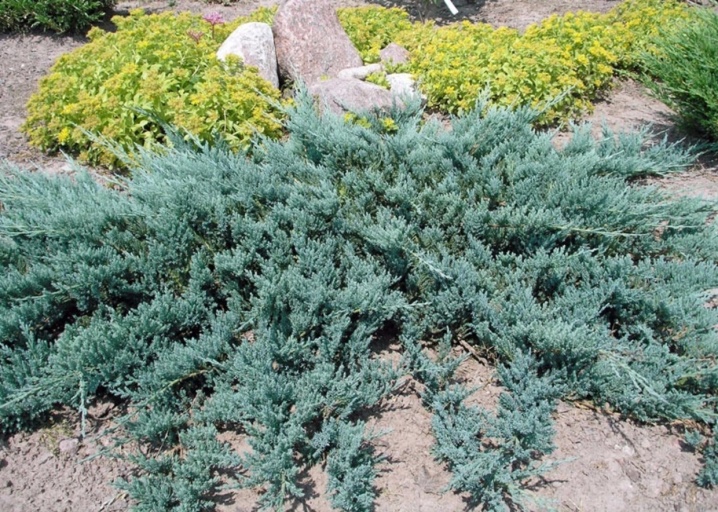
"Ice blue"
A dwarf bush usually has a height of only 15 cm and a width of almost 2 m. The crown has such a high density that the bush seems thicker and longer. Scale-like needles are colored green with a blue tint; by winter they acquire a violet-blue tone.

"Blue Forest"
The compact bush is distinguished by flexible short branches growing densely to each other with vertical lateral shoots. Dense needles in the form of needles have a deep blue color. It is distinguished from other varieties by its higher growth - up to 40 cm with a small bush width - only about 50 cm.
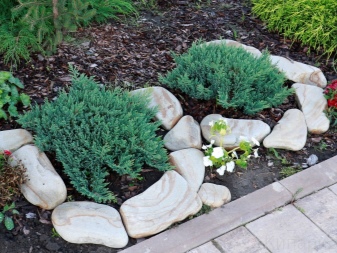
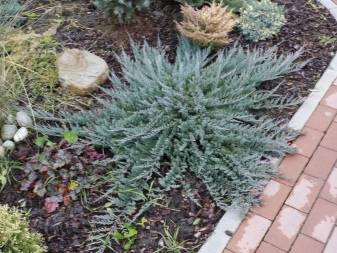
"Prince of Wales"
A variety that gives a width gain of only 6-7 cm in 1 year.Dense needles in the form of scales adhere tightly to the twigs and are colored bluish-green, which acquires a golden brown hue in winter. The height of the bush reaches 15-20 cm, and the crown width can be about 2.5 m. The plant is unpretentious and grows even on rocky ground, but loves moisture.
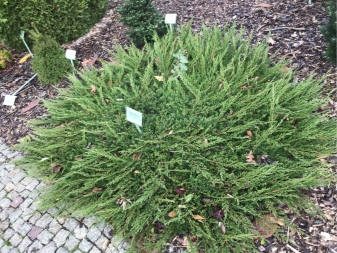
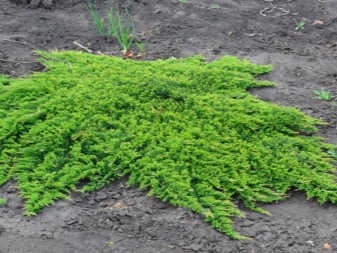
"Golden Carpet"
The maximum height of an adult bush is approximately 30 cm, the width of the crown is up to 1.5 m. The main branches are close to the ground and are able to quickly take root. The needles in the form of needles are painted bright yellow on top, and the lower surface has a greenish tone. By winter, the needles turn brown.
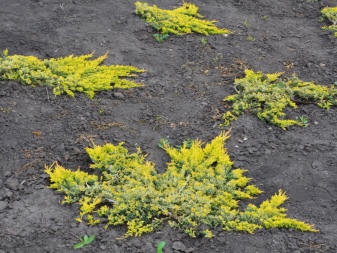
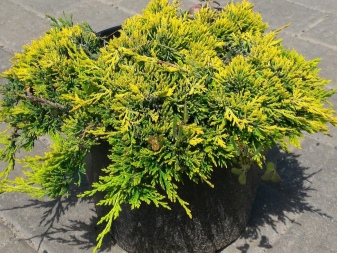
"Agnieszka"
Low-lying juniper with long skeletal branches slightly raised at a slight angle. The crown has a lush, slightly protruding needles, green with a bluish tint, which can be both needle and scaly. The color of the needles in winter changes to red.
A young bush has the shape of a pillow, and then, expanding, covers the ground with a carpet.
By the age of 10, it can grow up to 20 cm high and 1 m wide, and the maximum size of the bush is 40 cm and 2 m, respectively.


"Nana"
A low-growing recumbent species, reaching a height of 20 to 30 cm.The width of the crown is quite large - about 1.5 m, during the year the plant can increase in width by 15 cm.
The ends of short, but rigid branches are slightly raised upward. Shoots grow very densely. The needle-shaped soft and small needles are painted in gray-blue color with a waxy coating.
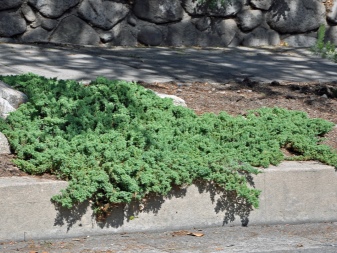

"Glauka"
This variety is also small in size: by the age of 10, the bush reaches 20 cm in height and 50 cm in width. The maximum size of an adult bush can be 40 cm and 2 m, respectively. The needles in the form of scales are close to the branches and have a bluish-green color all year round.
A variation of this variety is "Glauka Cossack". It can be attributed to a fast-growing species of juniper, which begins to grow rapidly from the age of 2-3. Its maximum height can reach 1 m, and its width - 5 m.
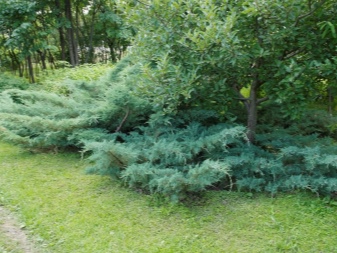
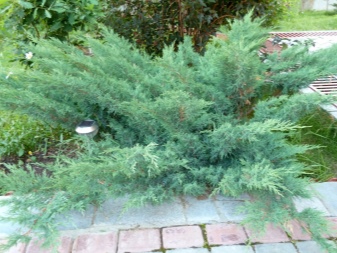
"Glacier blue"
This shrub differs from other varieties with its unusually beautiful needles of the most intense blue color. In summer, the needles have a brighter blue color, which turns brown in winter.
The dwarf bush grows up to 10 cm in height and 1.5 m in width. The lower branches are in the form of a roller. The crown is dense and lush.

"Prostrata"
A variety, the height of which in an adult plant is about 30 cm, the diameter of the crown is about 2 m.At the age of 10, its dimensions reach, respectively, 20 cm x 1.5 m.
The needles in the form of scales are painted in a gray-blue hue in spring, which turns greenish in summer and brown in winter. In the first years of growth, the crown with long and thick branches looks like a pillow. The ends of the branches and lateral processes are slightly raised.
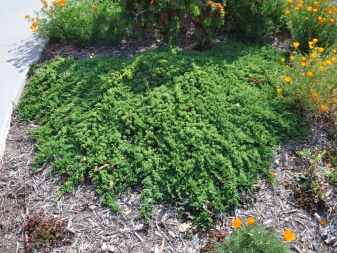
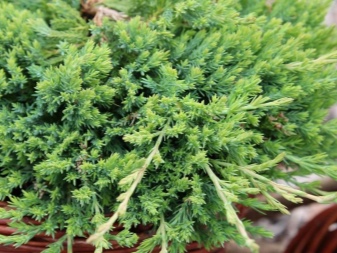
"Pancake"
"Pancake" is one of the flattest horizontal junipers, which is reflected in its name (translated "pancake"). For 10 years of growth, it reaches a height of about 4 cm, and the width of the crown is 40-50 cm.The maximum dimensions can be as follows: height - 10 cm, width - 1.5 m.
The needles in the form of very small scales are painted gray-green with a bluish-whitish tint. In winter, they take on a golden brown hue. The crown with long branches is strongly pressed against the soil.
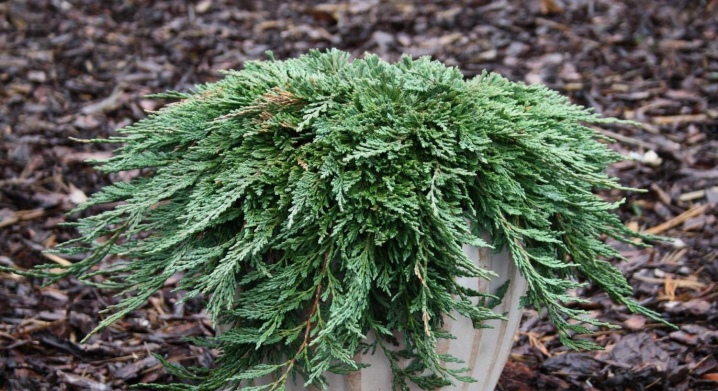
Landing rules
Quality seedlings for planting should be purchased from specialized stores or nurseries. You need to choose only seedlings without damage and signs of disease. The roots must be developed. In a healthy seedling, they are white, flaccid and have a pleasant smell.
It is recommended to choose a bush with a lump of soil on the roots so that the plant takes root faster. The best age for planting a seedling is about 3-4 years.
It is also important to choose the right landing site. This type of juniper prefers spacious, well-ventilated and well-lit areas with light and poorly nutritious soil. Avoid places with close groundwater table.
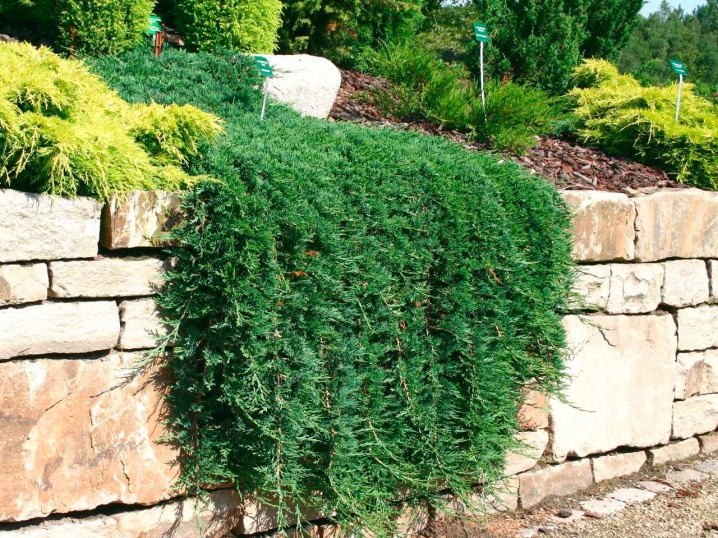
You can plant seedlings in spring (April - May) and autumn (late August - early September). It is important to plant the seedling correctly. This is how it is done.
To prevent possible diseases, you must first hold the roots of the bush in a solution of potassium permanganate for about 2 hours.
Prepare a sedimentary pit. Its depth should be in the range of 70-80 cm, and its width should be approximately 2-2.5 times greater than the soil ball on the roots. A drainage layer (10 cm) is laid on the bottom - pebbles, crushed stone, large expanded clay, then sand with a layer of 10-20 cm.
Fill in a soil substrate consisting of turf (1 part), peat (2 parts) and sand (1 part). Water the hole well.
Place the seedling so that its root collar is flush with the soil and does not go deeper.
Cover with potting soil. Then water the soil under the bush again.
Place mulch (peat, humus, sawdust) on top near the trunk with a layer of about 8 cm.
When planting several bushes, the distance between them should be approximately 1-2.5 m, taking into account the variety and their further growth. The close fit is done for a solid green carpet design.
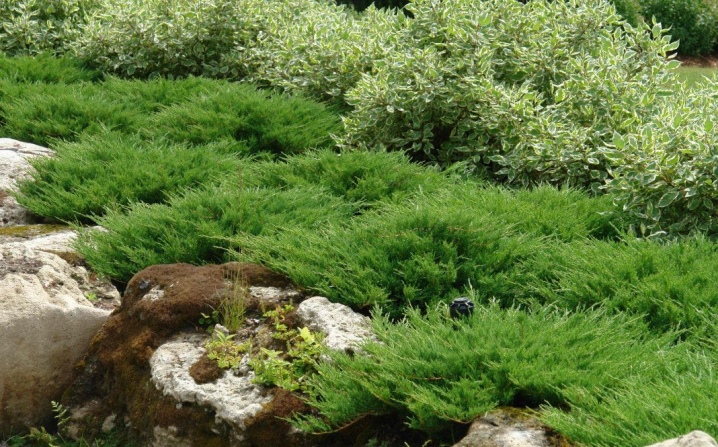
How to care?
The horizontal juniper is considered an unpretentious plant. Caring for him includes the usual agrotechnical actions.
Watering
The plant has good drought tolerance and does not require abundant watering. In spring and autumn, you need to carry out abundant cumulative watering.
In the summer, it is enough to water it once every 30 days, 1.5-2.5 buckets under a bush.
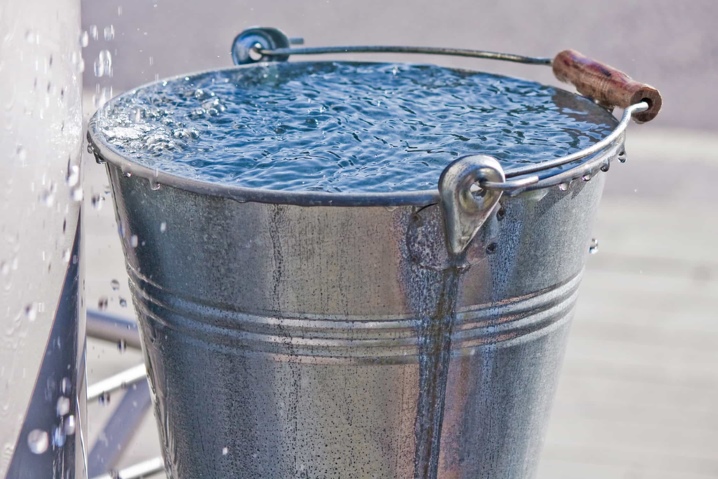
The juniper does not tolerate dry air well, therefore, in dry weather, it is required to spray the crown 1 or 2 times in 7 days. In rainy weather, they are reduced to 1 time in 18-20 days.
- Mulching. It is necessary in order to prevent the growth of weeds, to maintain soil moisture, and in winter to protect the roots from frost. In addition, there is no need to loosen the soil under the bushes. Mulch needs to be replaced from time to time with a new one.
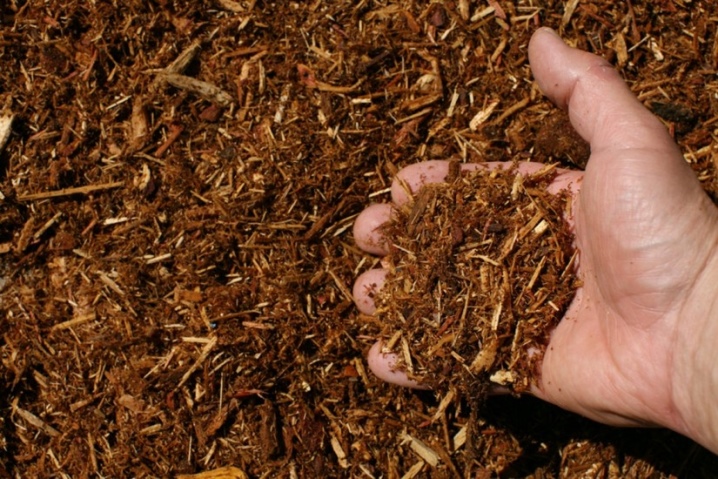
- Top dressing. Fertilizing is recommended every spring. For top dressing, you can use complex mineral fertilizers intended for conifers, or nitroammofosku. When feeding a bush, you need to strictly adhere to the norm, since the plant does not tolerate an excess of fertilizers.
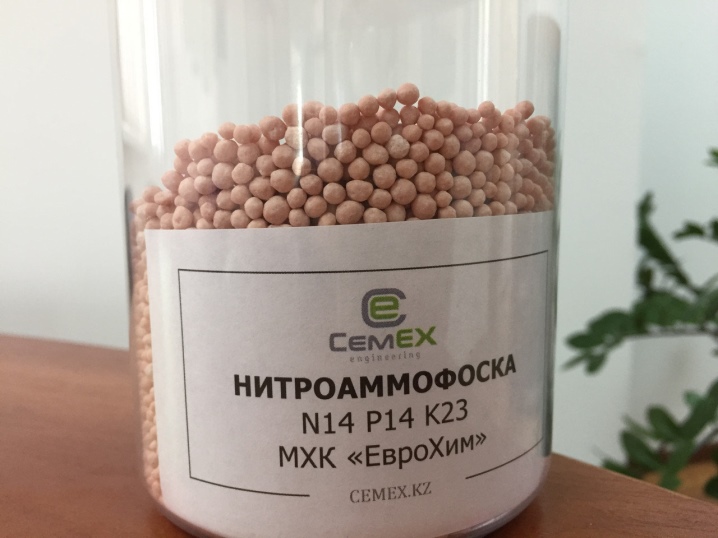
- Sanitary haircut and crown shaping. After a thorough inspection in the spring, it is necessary to cut and remove all dry, damaged and with signs of disease.
To give the juniper a certain shape, it should be trimmed, removing healthy excess shoots. However, it is permissible to cut no more than 7 cm so as not to cause a disease in the bush.
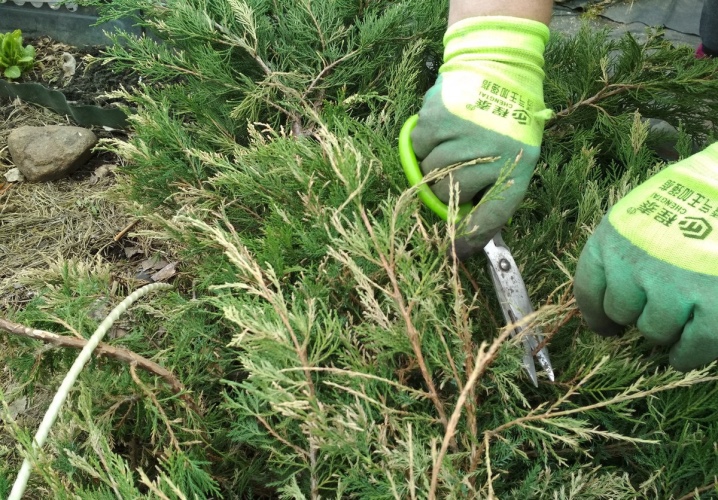
Shelter
To protect the needles from sunburn, in the spring it is necessary to cover the bushes with a protective mesh, which is opened a little every day, gradually increasing the lighting time by 15-20 minutes until the plant is fully adapted to ultraviolet light.
At the end of autumn, it is recommended to tie the branches with a rope in order to shake off the snow from them in winter, otherwise the branches will break off under its weight.
Young (1-2 year old) bushes must be covered with some kind of cover or canopy.
It should be noted that the juniper does not tolerate a transplant, so it is undesirable to do it. However, if it is nevertheless necessary, then the selected bush is carefully dug out, trying not to damage the roots, and then it is planted in the same way as an ordinary seedling.

Reproduction methods
You can propagate a juniper by seeds and by cuttings.
The seeds are preliminarily subjected to stratification. To do this, they are sown in a container with peat. Then they are taken out into the street, where the containers are kept until mid-spring. You can sow seeds in May.Previously, they are placed first in a solution of potassium permanganate for half an hour, and then for 2 hours in a solution of liquid fertilizer, and only after that they are planted in pre-prepared beds. The planting pattern is 50 cm between the holes and 80 cm between the rows.
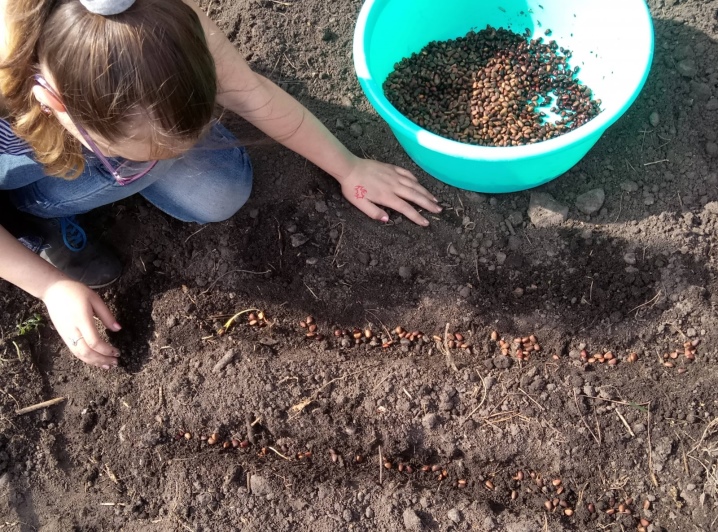
- Propagation by cuttings should be done in early spring. Cuttings are cut from an adult bush. Their length is about 12cm, and they need to be cut with a small section of the trunk (2-3cm). All needles should be removed from the cuttings, and then held for 24 hours in a solution of fertilizers that stimulate root growth. After they are planted in containers with a substrate consisting of turf soil, peat and sand, taken equally, deepening the cuttings by 3 cm. Then the soil is watered and covered with a film. The containers are kept in a room with a temperature of + 22-28 degrees in a bright place, constantly keeping the soil moist, but not overmoistening it. The film must be removed to air the cuttings at intervals of 5 hours.
After about 1.5 months, the cuttings will take root, but they can be transplanted into other containers only after another 2 months. In open ground, seedlings are planted in 2-3 years.
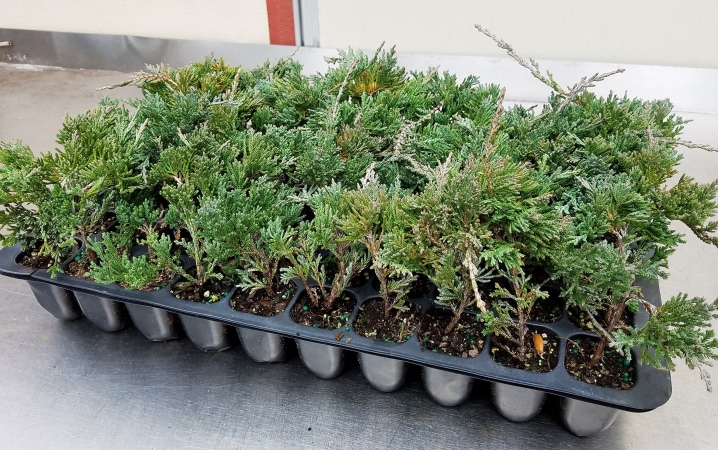
Diseases and pests
The prostrate juniper is resistant to diseases and pests, however, it can also hurt. The most common of his diseases are as follows.
Rust
A dangerous disease in which orange growths form on the trunk and branches, and the needles turn brown and dry. The diseased parts of the plant should be cut off, and the bush should be treated with drugs that stimulate immunity and liquid micronutrient fertilizers. For prevention, it is necessary to exclude the neighborhood with hawthorn, mountain ash, pear - sources of rust infection.
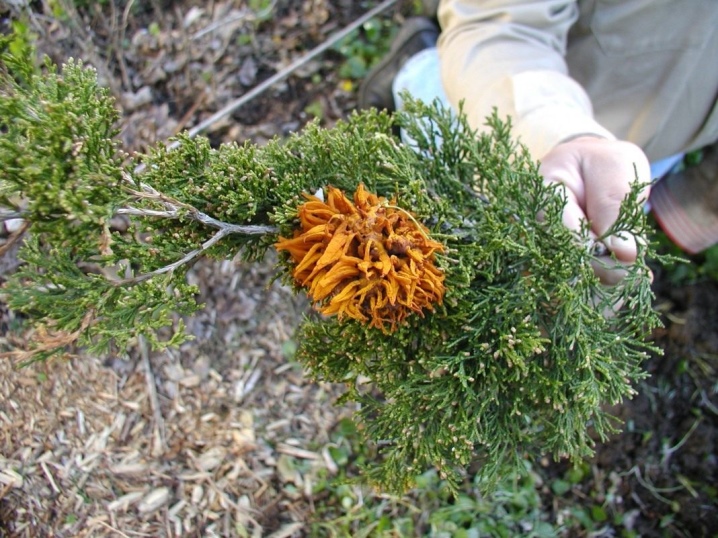
Schütte
The first signs of the disease appear on last year's needles at the very beginning of summer: it becomes dirty yellow or brown in color, but does not crumble for a long time. At the end of summer, black spots form on it - fungal spores. Affected needles should be promptly removed, and in case of extensive infection, spray with "Hom". For prevention, in spring and autumn, the bushes are treated with Bordeaux liquid (1%).
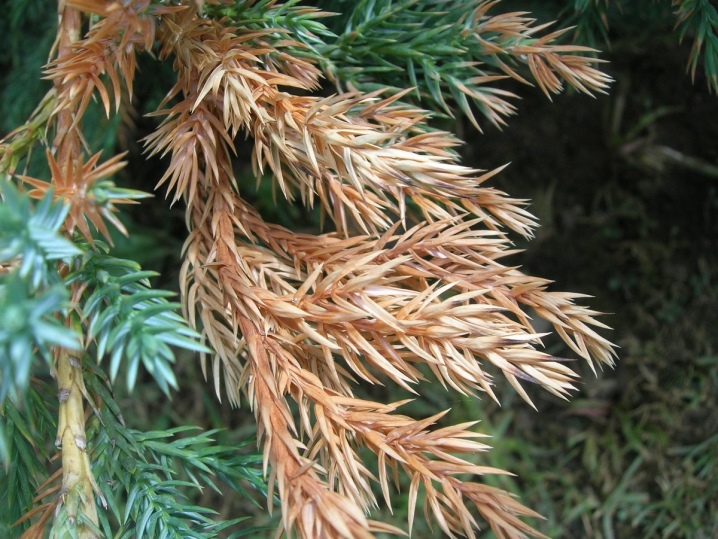
Fusarium or root rot
The cause of the disease is excess moisture. The needles turn yellow and then die off. All diseased bushes must be removed by the root. To prevent the disease, the seedlings are disinfected with the preparations "Maxim", "Vitaros" before planting, and the soil is treated with the "Funazol" agent.
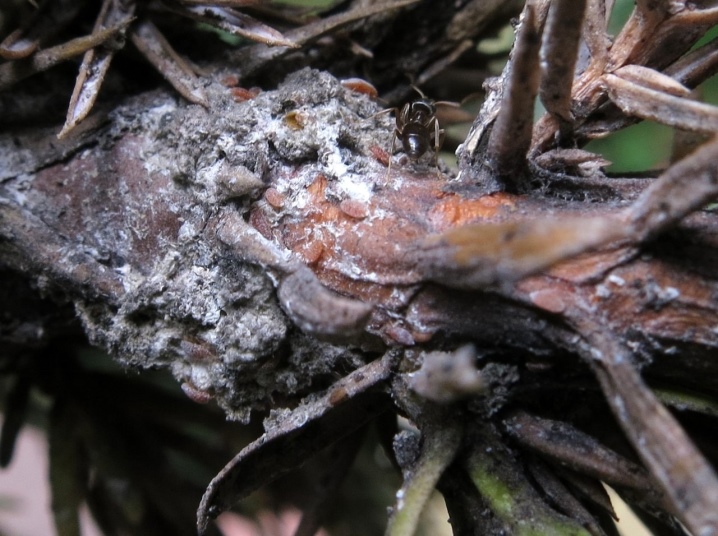
Fungal infections
Fungal infections can also cause the branches to dry out, where black or brown spots first appear. Then the needles turn yellow, the branches dry up.
The diseased branches are cut off. For further treatment, fungicides are used, and for prevention - spraying in the spring with preparations containing copper and sulfur.
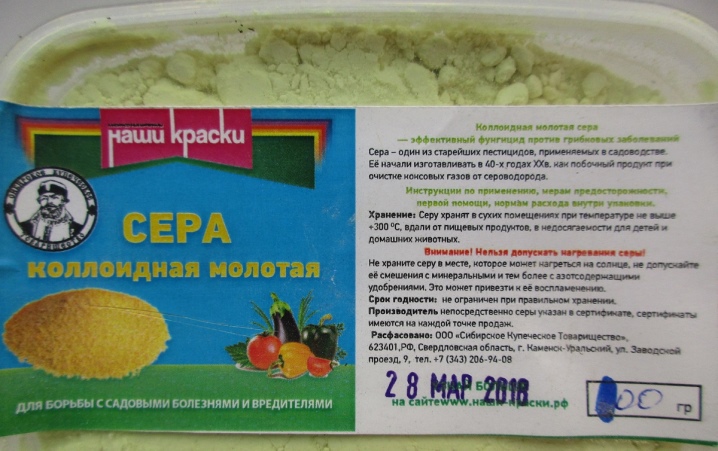
The plant is most often affected by such pests.
Aphid. It mainly affects young bushes. To destroy its colonies use insecticides "Fufanon", "Decis", "Aktar". It is also necessary to conduct timely control of ants that contribute to the spread of aphids.
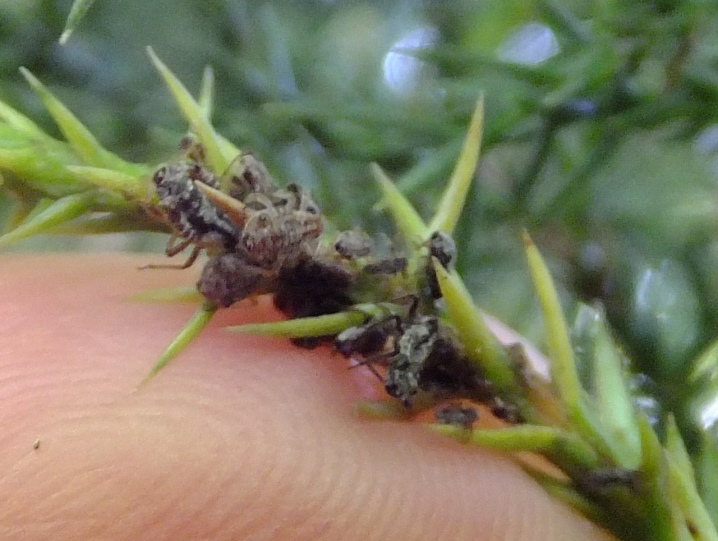
Shield. The insect infects the needles, on which small brown swellings appear, which leads to the death of the bark and the curvature of young processes. The shield can be collected manually or using trapping belts, and then treat the bushes with insecticides (Fitoverm, Aktellin).
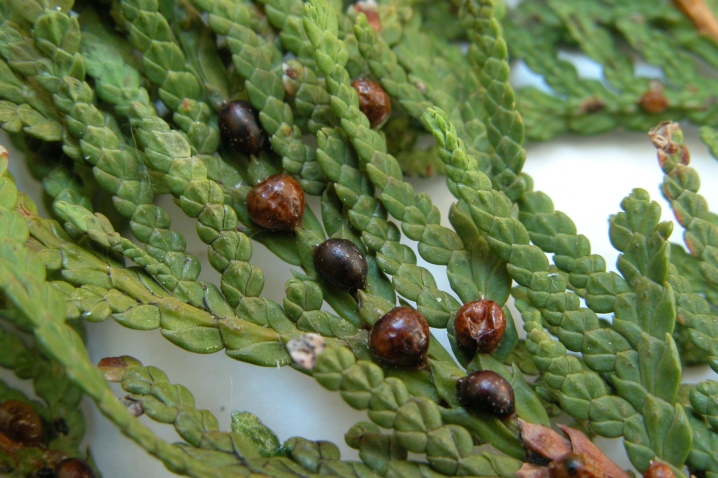
Spider mite. A sign of its appearance is the formation of a thin web on the crown. Spraying with cold water, which insects cannot tolerate, helps fight ticks. The use of drugs-acaricides - "Vermitek", "Fufanon" is also effective.
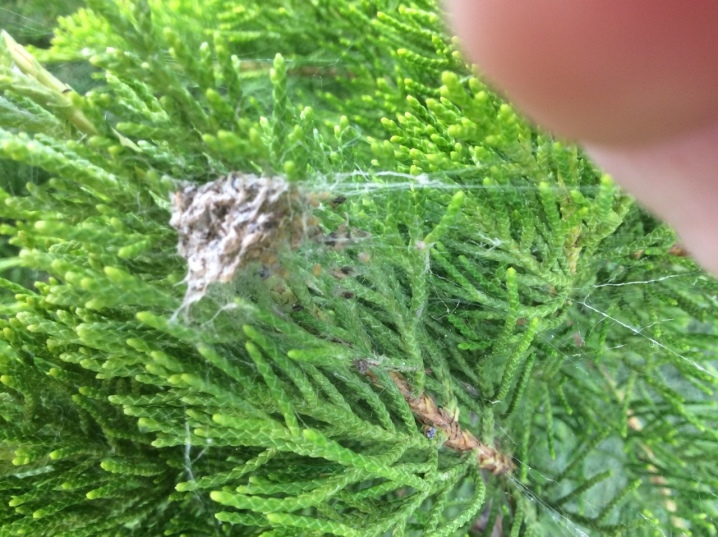
Use in landscape design
It should be noted that using only one horizontal juniper for landscape design results in a monotonous and uninteresting landscape. However, the picturesque islets of plants with needles of different colors will perfectly hide the ugly voids of the site.

Professional designers use it in compositions with other plants, especially often in combination with perennial flowers. It complements well the group planting of low-growing trees and other ornamental shrubs. Heather and dwarf barberry look great next to junipers, especially in rocky areas.
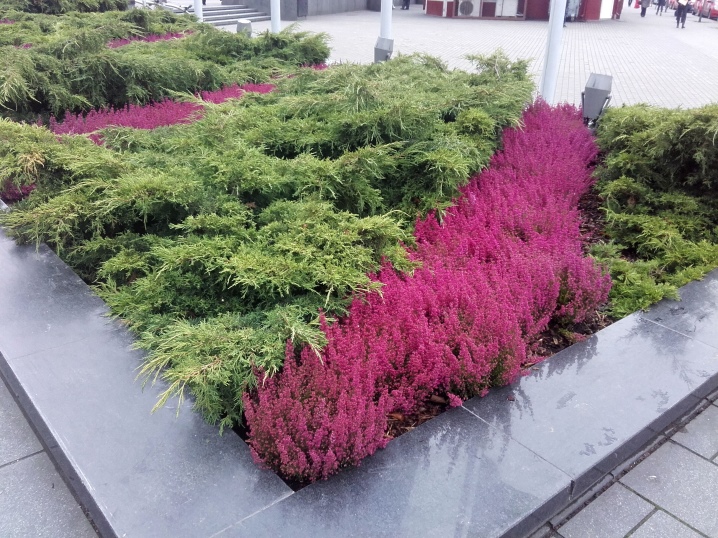
This ephedra is also often used in the design of alpine slides and gardens, rockeries. Decorative compositions of horizontal juniper with its vertical views, dwarf spruces and other conifers also look picturesque.
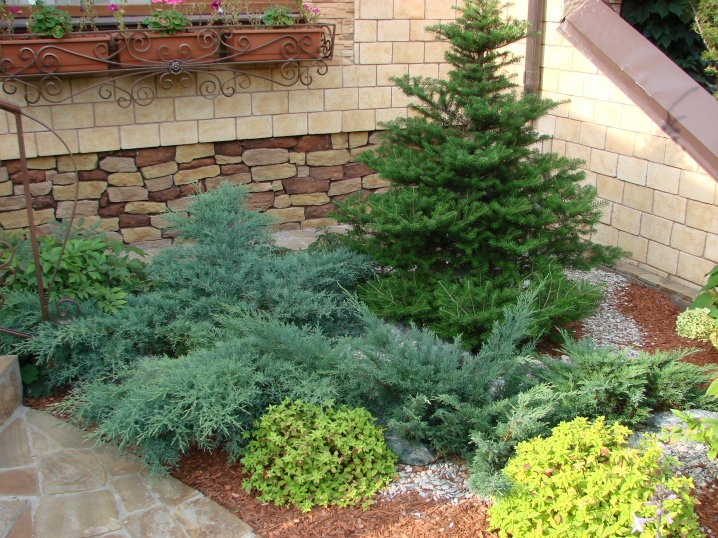
How to use horizontal juniper in garden design, see below.



































































The comment was sent successfully.